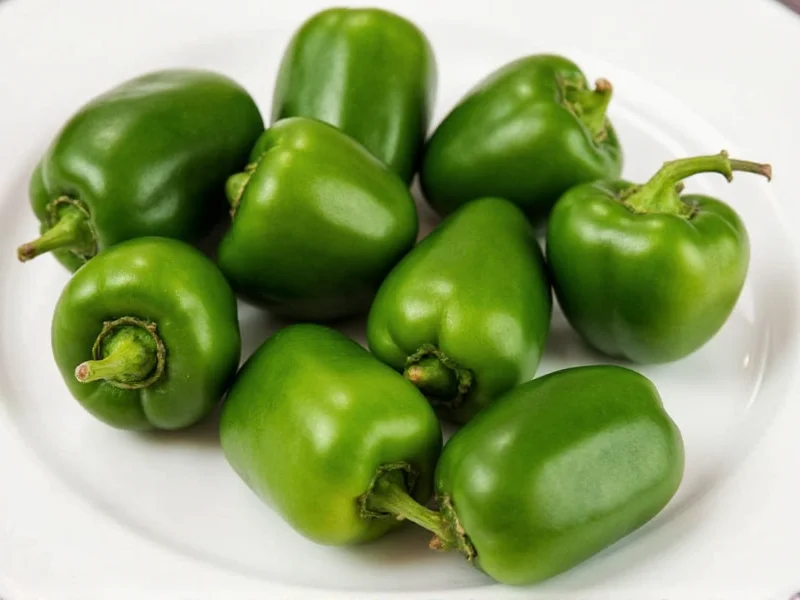When comparing poblano vs jalapeño heat levels, understanding the Scoville scale is essential. This measurement system quantifies capsaicin concentration—the compound responsible for chili pepper heat. The significant difference between these two popular peppers explains why they serve distinct culinary purposes despite both being staples in Mexican cuisine.
Understanding Pepper Heat Measurement
The Scoville scale, developed by pharmacist Wilbur Scoville in 1912, remains the standard for measuring chili pepper heat. Originally determined through human taste testing, modern laboratories now use high-performance liquid chromatography (HPLC) for precise capsaicin quantification, then convert results to Scoville Heat Units.
Pepper heat varies considerably based on growing conditions, soil composition, climate, and even the specific plant. This natural variation explains why two jalapeños from the same plant might differ in heat intensity.
Poblano Pepper Profile
Poblanos (Capsicum annuum) originate from Puebla, Mexico, and are considered mild to medium-hot peppers. When fresh, they're dark green, heart-shaped, and measure approximately 4–6 inches long. As they mature and turn red, their heat level increases slightly while developing a richer, slightly sweet flavor.
Chefs value poblanos for their complex flavor profile that includes earthy, smoky notes with minimal heat. When dried, they become ancho peppers, which feature prominently in mole sauces and other traditional dishes.
Jalapeño Pepper Profile
Jalapeños (Capsicum annuum) hail from Xalapa, Mexico, and deliver noticeably more heat than poblanos. These 2–3.5 inch peppers start bright green and darken to red as they mature. Their heat intensifies with ripeness, though the flavor also develops more sweetness.
The distinctive jalapeño flavor combines grassy, vegetal notes with significant heat that builds gradually. They're versatile enough for fresh salsas, pickling, stuffing, and smoking (when smoked, they become chipotles).
Direct Heat Comparison: Poblanos vs Jalapeños
| Pepper Type | Scoville Heat Units | Relative Heat Level | Common Culinary Uses |
|---|---|---|---|
| Poblano | 1,000–2,000 SHU | Mild (similar to banana peppers) | Chiles Rellenos, mole sauces, roasted dishes |
| Jalapeño | 2,500–8,000 SHU | Moderate (3–8x hotter than poblanos) | Salsas, nachos, pickled peppers, stuffed peppers |
| Comparison Reference | 0 SHU | Mild | Bell peppers (no heat) |
| Comparison Reference | 15,000–30,000 SHU | Hot | Serrano peppers (2–12x hotter than jalapeños) |
Factors That Influence Pepper Heat Levels
Several variables affect how hot your poblanos or jalapeños might be:
- Stress conditions: Peppers grown in drier, hotter conditions often develop more capsaicin as a defense mechanism
- Ripeness: Fully mature red jalapeños can be significantly hotter than green ones
- Plant position: Peppers growing in direct sunlight typically develop more heat
- Seed placement: The placenta (white ribs) surrounding seeds contains the highest capsaicin concentration
This explains why you might occasionally encounter an unusually hot poblano or a surprisingly mild jalapeño. When substituting one for the other, always taste a small piece first to gauge actual heat level.
Culinary Applications and Substitutions
Understanding the poblano vs jalapeño heat difference helps determine appropriate substitutions:
- Substituting jalapeño for poblano: Use half the amount of jalapeño, remove seeds and ribs, and consider balancing with dairy or acid
- Substituting poblano for jalapeño: You'll need to increase quantity or add complementary heat sources like cayenne
- For mild dishes: Poblanos work better in stuffed pepper recipes where heat shouldn't dominate
- For noticeable heat: Jalapeños provide the kick needed in salsas and nacho toppings
When roasting either pepper, the process caramelizes natural sugars while slightly reducing perceived heat. This technique makes both peppers more versatile across different heat preferences.
Managing Heat in Cooking
Several techniques help control pepper heat in your dishes:
- Remove seeds and white ribs (placenta) where most capsaicin concentrates
- Soak sliced peppers in vinegar or citrus juice to neutralize some capsaicin
- Add dairy products like sour cream or cheese to counteract heat
- Balance with sweet elements like honey or roasted vegetables
- Wear gloves when handling hot peppers to prevent skin irritation
Remember that cooking doesn't destroy capsaicin—it merely distributes it throughout your dish. The heat remains stable through baking, boiling, and frying processes.
Frequently Asked Questions
Can I substitute jalapeños for poblanos in recipes?
Yes, but with adjustments. Since jalapeños are significantly hotter, use approximately half the amount of jalapeño when substituting for poblanos. Remove seeds and ribs to further reduce heat, and consider balancing with dairy or acid components. For stuffed pepper recipes, this substitution works best when you want more noticeable heat.
Why are some poblanos hotter than others?
Poblano heat varies due to growing conditions—drier, hotter climates produce hotter peppers as a defense mechanism. Sun exposure, soil composition, and water stress all influence capsaicin production. Even within the same plant, peppers receiving more direct sunlight typically develop more heat. This natural variation explains why you might occasionally encounter a poblano with unexpected heat.
Which pepper is better for sensitive palates?
Poblanos are significantly better for sensitive palates, measuring just 1,000–2,000 SHU compared to jalapeños' 2,500–8,000 SHU. Their mild heat allows the complex earthy, smoky flavors to shine without overwhelming spice. For children or those with low heat tolerance, roasted poblanos provide excellent flavor with minimal burn, making them ideal for stuffed peppers, soups, and sauces where heat shouldn't dominate.
Do red jalapeños taste different from green ones?
Yes, red jalapeños are fully mature versions of green jalapeños and offer a noticeably different flavor profile. They develop more sweetness and fruitiness as they ripen while increasing slightly in heat. The red color indicates higher carotenoid content, which contributes to a richer, more complex flavor. Many chefs prefer red jalapeños for salsas and sauces where a balance of heat and sweetness is desired.











 浙公网安备
33010002000092号
浙公网安备
33010002000092号 浙B2-20120091-4
浙B2-20120091-4